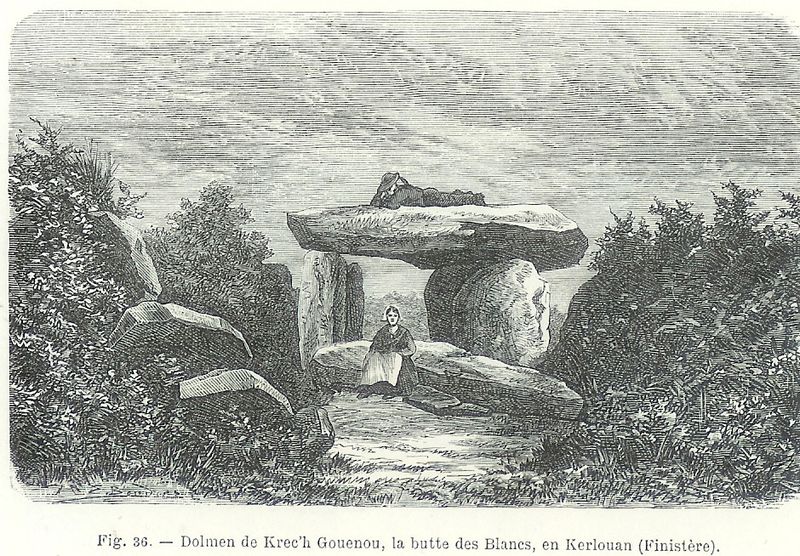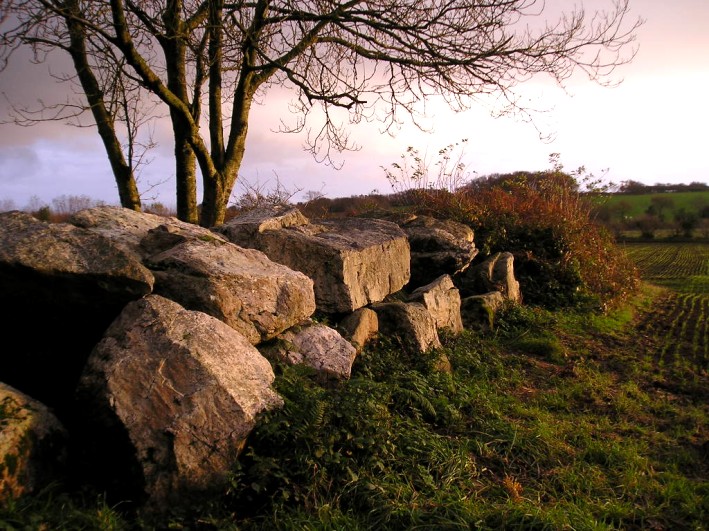<< Books/Products >> Book Review: Numbers of the Gods - Unlocking the Secret Science of the Druids
Submitted by cerrig on Tuesday, 27 December 2016 Page Views: 8437
ReviewsCountry: France
"First, my research for this book soon led me to contemplate the possibility that Druidic knowledge was far older than orthodox historians usually think it is. Second, it soon became just as obvious that this Druidic knowledge had not disappeared with the Druids, but that it had probably-- and secretly-- lived on until this very day. That makes two bold assertions already."
"Finally, there was little doubt that this knowledge was, and indeed still is, of extreme importance. Not only does it include advanced mathematics, geometry and astronomy, but it also happens to reveal a beautiful harmony in our world, ie. a mathematical order which is highly reminiscent of the harmony of the spheres referred to by Pythagoras in antiquity. Pythagoras believed there was a harmony in the cosmos, a beautiful order of things, and that the movements of the celestial spheres, such as the sun, the moon and the planets, produced an imperceptible music which made human life on earth harmonious. He may have called this celestial hum the ' music of the heavens'. His followers, the Pythagoreans, thought the earth and the other heavenly spheres were separated from one another by intervals corresponding to beautiful numerical proportions similar to the harmonic lengths of strings, and that the movements of these bodies gave rise to this mysterious music."
"In this book we'll see that this mathematical harmony of our world appears to exist, to an extent that was never clearly perceived until very recently-- a true 'music of the spheres' played out by our tiny part of the universe with three numbers (366, 40 and 10, which I allegorically refer to as the 'Numbers of the Gods' in my title, or as the 'Divine Triad' in this book, although in my view these nicknames are more poetical and philosophical than religious). Just as important, these three numbers are encapsulated in an ingenious integrated geometry and astronomical knowledge that Druids and their descendants appear to have passed down across the generations."
The full Prologue is ten pages long. As is apparent the Author writes in a clear, engaging and interesting manner that flows along nicely. This is maintained mostly all the way through the book, and at 413 pages, with 20 chapters in four parts, and appendices, it's just as well!
Sylvain’s aim is to show that the Druids, their ancestors and descendants, have secretly kept alive a body of knowledge until the present day. In order to do this he initially (in part 1) traces the history of the Druids using known historical sources, mainly Greek and Roman. He looks into the Druids’ beliefs and customs, their scientific knowledge - principally astronomy and geometry, and their tendency toward keeping and passing on this knowledge in a secretive manner, which is the main tenet of this book.
Part 1 contains a multitude of quotes and references, perhaps a few too many than was really necessary to make the case - given that there is no real contention in any of the evidence presented here - unless you are of a definite frame of mind regarding Druidical history. For most people this won't be an issue, and Sylvain’s views can be taken as an accurate account of the evidence, with no surprises to be found. Until Sylvain drops in a real gem.
This isn't so much about the Druids as such, but the history of French interest in ‘earth mysteries’ in general. It seems that 'The Old Straight Track' idea of ley lines is alive and well in France, and has been for at least 80 years. In 1936 Xavier Guichard brought out a book investigating the relationship between certain French place names and their geographical locations in relation to one another. He plotted similar names and found they lay on a kind of grid, the lines of which he named 'salt lines'. There’s more than a passing resemblance to Alfred Watkins’ ley line system here. Xavier also attributed the Bronze age peoples with scientific knowledge and a system of measures. This kind of interest seems to be thriving in France, and Sylvain is one of several modern investigators exploring much the same theme now as Xavier did 80 years ago, with seemingly little change to the central focus of aligned settlements, but with a more up to date slant on it and some notable additions. I personally had no idea France was a 'hot bed' of such things, so this was a surprise to me.
 Part 2 goes back to the Neolithic and the megalithic builders, and Sylvain brings in sites from Scotland and Asia, to America, with the incidence of sites making up a world grid. This will be familiar territory to lots of people with the ‘usual suspects’ being part of the grid. (Stonehenge, Avebury, the Pyramids etc.) There are some intriguing configurations of sites in Asia, South America and elsewhere, but it has to be said that there are also lots of places not mentioned as part of the proposed grid. This point isn't really debated as Sylvain concentrates on the sites that do conform to his grid, and there are enough of these in significant places to at least suggest the grid may be a reality, if a poorly understood reality. There is more evidence later on to back this up.
Part 2 goes back to the Neolithic and the megalithic builders, and Sylvain brings in sites from Scotland and Asia, to America, with the incidence of sites making up a world grid. This will be familiar territory to lots of people with the ‘usual suspects’ being part of the grid. (Stonehenge, Avebury, the Pyramids etc.) There are some intriguing configurations of sites in Asia, South America and elsewhere, but it has to be said that there are also lots of places not mentioned as part of the proposed grid. This point isn't really debated as Sylvain concentrates on the sites that do conform to his grid, and there are enough of these in significant places to at least suggest the grid may be a reality, if a poorly understood reality. There is more evidence later on to back this up.In part 2 the work of Alan Butler and Christopher Knight is brought in, and in particular their work on the Phaistos disc and 366 degree geometry. This is closely followed by Alexander Thom and the megalithic yard. Sylvain uses the work of others quite shamelessly throughout, but he is very sympathetic and respectful, and the combined efforts are merged together very well. All the authors are attributed accordingly, even if it is sometimes difficult to tell who wrote what.
Part 3 brings us up to the present day; from Roman times through medieval, and this is where I was most surprised. Sylvain’s evidence of 'shenanigans' involving the siting of structures in France during the last couple of centuries (without giving too much away) is quite compelling, and something else that I hadn't come across before. Again, Sylvain is not alone in his suspicions, and he references several other authors from what seems to be a busy French alignment theory community.
This is the part that really cements the mystery and secrecy together, and points the finger too. It takes a while to get here but all in all it's probably worth the journey.
Part 4 concludes the book, excluding the appendices and glossary. This part concerns itself with the nuts and bolts of the proposed science, whereby time, distance and physical constants have been combined in an integrated system, similar to the metric system but much older. This is the shortest part of the book but it contains a lot of information on this system, all written in plain English with the minimum of maths. Well worth reading in it's own right.
It’s all in all, a very well written book with copious quotes and references, illustrated throughout, and many Google Earth maps that can also be viewed online if preferred. Sylvain has woven together evidence from 7000 years of history from multiple authors into a comprehensive volume. It's not a Dan Brown type page turner but it still flows nicely from start to finish. Anyone interested in this field should find it illuminating.
I'm not sure that Sylvain has made a totally convincing case for a continuous tradition of Druidical type lineage, but he has advanced his cause considerably. There are some issues that are far from settled by this book, but none the less it is a very worthwhile addition to the ancient science debate.
I can recommend this book to Megalithic Portal readers.
Review by Cerrig
 Numbers of the Gods - Unlocking the Secret Science of the Druids, Author: Sylvain Tristan
Numbers of the Gods - Unlocking the Secret Science of the Druids, Author: Sylvain TristanPublished by Progressive Press
400 pages
RRP $19.95
Buy from Amazon.com or Amazon.co.uk
<< Book Review: The Archaeology of Nuragic Sardinia by Gary Webster
Book Review: Hermeneutics of Megaliths by Costas Maritsas >>



 We would like to know more about this location. Please feel free to add a brief description and any relevant information in your own language.
We would like to know more about this location. Please feel free to add a brief description and any relevant information in your own language. Wir möchten mehr über diese Stätte erfahren. Bitte zögern Sie nicht, eine kurze Beschreibung und relevante Informationen in Deutsch hinzuzufügen.
Wir möchten mehr über diese Stätte erfahren. Bitte zögern Sie nicht, eine kurze Beschreibung und relevante Informationen in Deutsch hinzuzufügen. Nous aimerions en savoir encore un peu sur les lieux. S'il vous plaît n'hesitez pas à ajouter une courte description et tous les renseignements pertinents dans votre propre langue.
Nous aimerions en savoir encore un peu sur les lieux. S'il vous plaît n'hesitez pas à ajouter une courte description et tous les renseignements pertinents dans votre propre langue. Quisieramos informarnos un poco más de las lugares. No dude en añadir una breve descripción y otros datos relevantes en su propio idioma.
Quisieramos informarnos un poco más de las lugares. No dude en añadir una breve descripción y otros datos relevantes en su propio idioma.